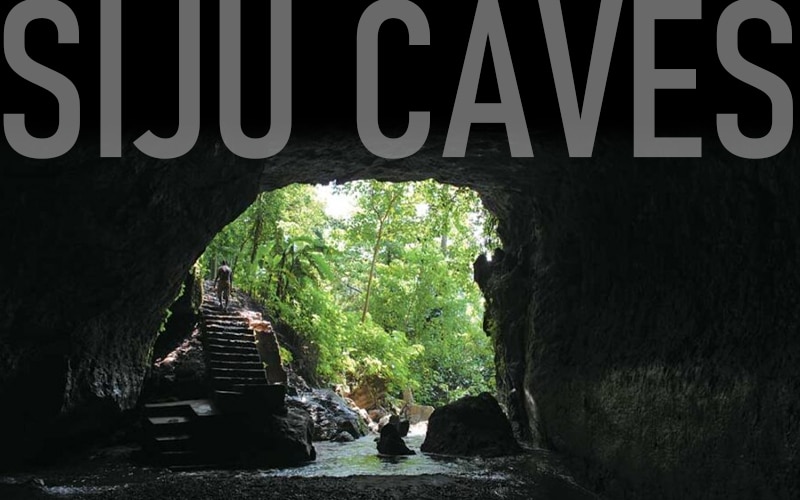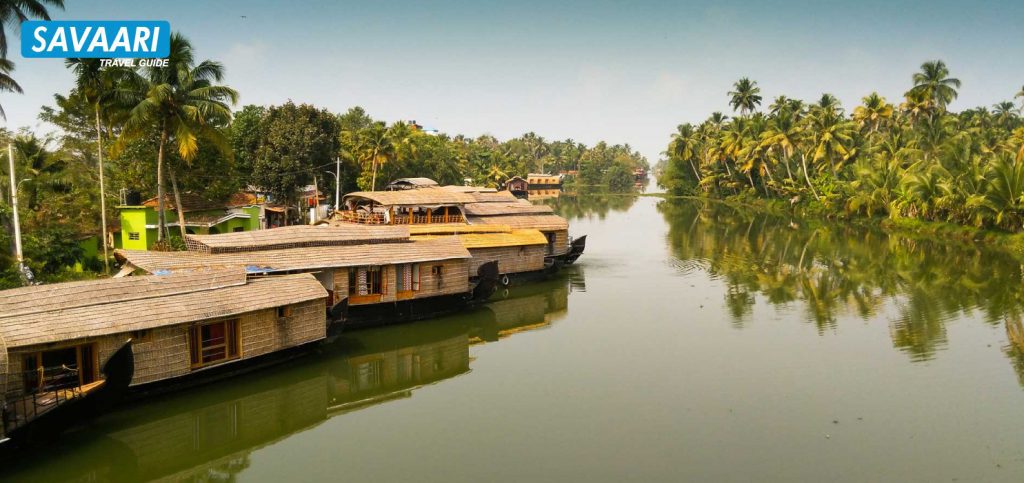Nestled amidst the majestic Himalayas in the verdant state of Uttarakhand, India, lies a sacred circuit. The circuit contains four celestial abodes that beckon with their otherworldly allure. Yamunotri, Gangotri, Kedarnath, and Badrinath—these four sanctified shrines collectively form the Char Dham. Char Dham Yatra is a revered pilgrimage that has been captivating the hearts and souls of devotees for centuries. In Hindi, the four shrines are referred to as “Char Dham,” which translates to “four abodes.” This comprehensive travel guide covers all aspects of the Dhams, from the mythological significance of each site to useful information like the Char Dham yatra route.
Savaari Car Rentals has curated an exclusive Char Dham Yatra package for pilgrims planning to visit one, two, or all four dhams. You can book comfortable Toyota Innova cabs or sedans from cities like Delhi, Dehradun, Haridwar, and Rishikesh based on your travel needs and darshan duration to cover any sacred shrine of your choice. Our Char Dham Yatra package price is flexible and you can book a roundtrip cab service for a comfortable journey and peaceful darshan. Ready to commence your Char Dham yatra? Book a Savaari cab today!
A brief context – Why undertake a trip to the Char Dhams?
Pilgrims undertake the Char Dham Yatra, a pilgrimage tour that encompasses the four sacred shrines, with the belief that it cleanses sins, offers an opportunity for spiritual upliftment, and helps attain moksha (salvation) by seeking the grace of the gods and deepening their connection with the divine. The Char Dham Yatra is not only a religious pilgrimage but also a journey through stunning natural landscapes, majestic mountains, and serene surroundings. As you embark on your Char Dham Yatra, let the mystique of its history, legends, and spiritual significance guide you on a profound journey of self-discovery, where the past and the present converge in a timeless quest for divine grace and enlightenment.

Table of contents
- Divine heritage – Tracing the history of Char Dham Yatra
- The sacred circuit – Char Dham Yatra route
- The Char Dhams and their significance
- Align with the divine – When to go on Char Dham Yatra
- A Pilgrim’s guide – How to prepare for Char Dham Yatra
- Spiritual heights – Char Dham Yatra by helicopter
- Other Char Dham transportation services
- Char Dham Yatra facilities for elderly and female travelers
- Flavors of faith – Culinary experiences in Char Dham Yatra
- Accommodation in Char Dham Yatra
Divine heritage – Tracing the history of Char Dham Yatra
The Char Dham is steeped in legend and lore, as narrated in Skanda Purana, the revered Hindu scripture. According to the scripture, Lord Vishnu assumed the form of Narasimha, a half-human and half-lion incarnation, to defeat the demon Hiranyakashipu. After vanquishing the demon, Lord Vishnu felt remorse for taking a life and sought penance in the Himalayas. According to belief, the shrines of Yamunotri and Gangotri were established at the places where Lord Vishnu meditated at the Yamuna and Ganga rivers, respectively.
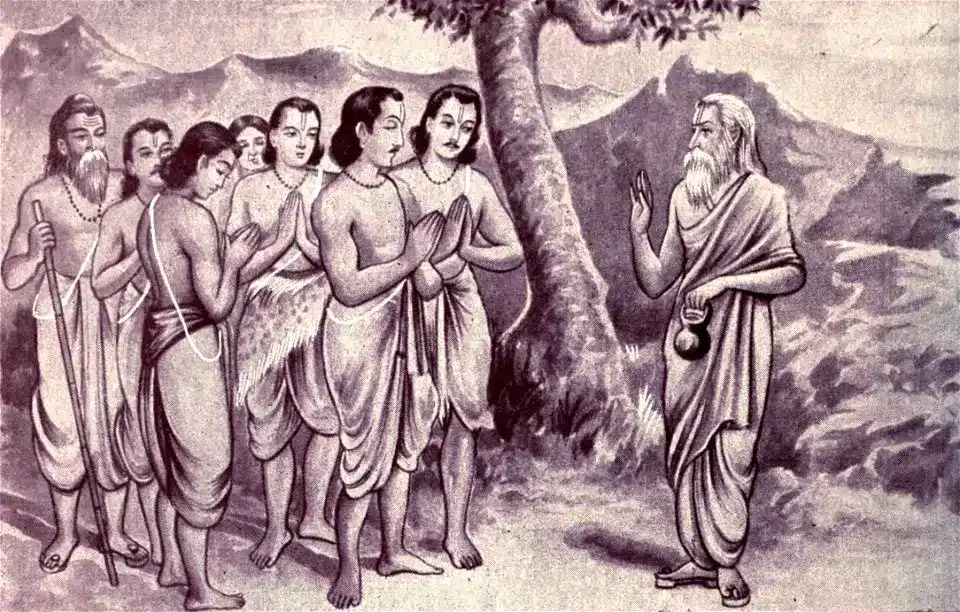
The legend associated with Char Dham also includes the story of the Pandavas from the Hindu epic Mahabharata. It is believed that the Pandavas undertook a pilgrimage to these four shrines to seek forgiveness for the sins committed during the Kurukshetra war. During their journey, each of the Pandavas left their mortal bodies one by one, ascending to the heavens. Only Yudhishthira, the eldest Pandava, completed the pilgrimage and attained liberation. The shrines of Kedarnath and Badrinath are considered highly auspicious and are believed to be associated with the Pandavas.
Adi Shankaracharya, a revered Hindu saint and philosopher, is credited with playing a significant role in establishing and popularizing the Char Dham pilgrimage in India. He is believed to have established the Kedarnath shrine and composed hymns and prayers dedicated to the Char Dham deities. Pilgrims continue to be inspired by his teachings on Advaita Vedanta, making him an important figure in its history. Additionally, Adi Shankaracharya composed several hymns and prayers dedicated to the Char Dham deities. Pilgrims still recite during the Char Dham Yatra.
The sacred circuit – Char Dham Yatra route
According to Hindu mythology, the Char Dham yatra route is considered highly auspicious and traditionally performed in a clockwise direction, starting from the west and moving towards the east. To go on this sacred journey, one needs to reach Rishikesh (or Haridwar), and from there, one can book a reliable taxi and continue the journey by road. The Char Dham route starts at Yamunotri, then goes to Gangotri, Kedarnath and, at last, Badrinath. Moreover, the four sacred destinations can be reached by road or helicopter, and also offer opportunities for trekking and adventurous exploration along the way.
The Char Dhams and their significance
In ancient times, the pilgrimage to Char Dham was predominantly undertaken by sadhus and wealthy individuals who could afford to travel with an entourage. However, after the Indo-China war in 1962, India made significant efforts to improve connectivity and infrastructure in the region. These efforts resulted in easier access to the Char Dham route, which in turn encouraged a larger population of Indians to embark on this spiritual journey in the Himalayas.
Each place on the Char Dham circuit map is steeped in rich historical and spiritual significance, with vibrant legends associated with them. Pilgrims often follow a specific route and visit each shrine in a particular sequence, as per the tradition. The yatra is facilitated by the Uttarakhand government and tour operators who provide transportation, accommodation, and other facilities for pilgrims.
Yamunotri Dham – The sacred shrine of river Yamuna

Located 220 km from Rishikesh, the revered Yamunotri Dham, nestled amidst the lush green Garhwal Himalayas, is a sacred pilgrimage site known as the origin spot of the Yamuna River. The temple gets its name from the river that flows past it, originating from the nearby glacier of Champasar at the foothill of the Bandarpoonch peak. Perched at an elevation of 3,293 meters, the temple is surrounded by natural hot water springs that are believed to possess medicinal properties.
According to popular legend, the sage Asit Muni had his hermitage by the banks of the Yamuna River and used to take holy dips in both the Ganga and Yamuna rivers as part of his daily ritual. However, due to old age, he was unable to continue this practice. As an expression of appreciation for his efforts, a stream of the Ganga River appeared opposite Yamuna, allowing him to continue his rituals. This divine event is considered an honour bestowed upon him by the rivers, and the temple at Yamunotri stands as a tribute to this legendary tale.
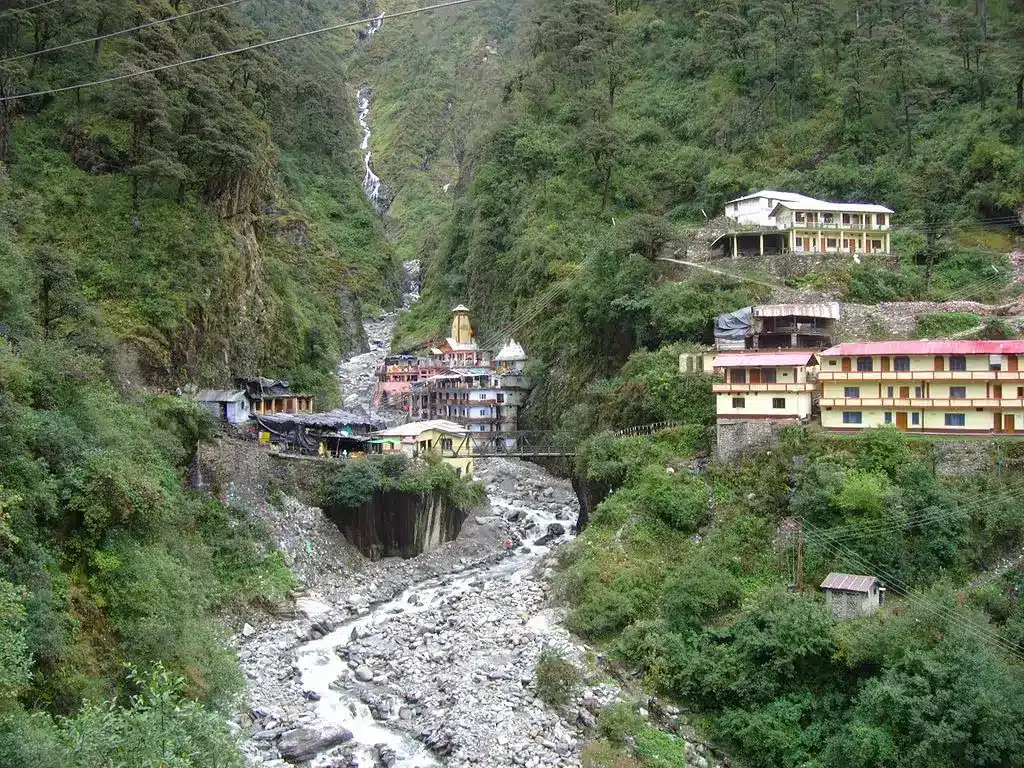
The temple of Yamunotri is not only a place of spiritual significance but also a site of immense natural beauty, with its awe-inspiring location on the edge of a cliff against the backdrop of the majestic Himalayas. The hot water springs around the temple add to its mystic charm, attracting devotees and tourists alike. The legend of Asit Muni and the natural beauty of Yamunotri Dham make it a revered sojourn for those seeking a divine connection with nature and spirituality.
Yamunotri Char Dham Yatra rituals
The following are some of the rituals performed at Yamunotri during the Char Dham Yatra:
- Yamunotri temple visit – The main ritual of Yamunotri Char Dham Yatra is the visit to the Yamunotri Temple, dedicated to Goddess Yamuna. Moreover, pilgrims take a holy dip in the hot springs of Yamunotri before visiting the temple to offer prayers and seek blessings from the goddess.
- Yamuna Aarti – Aarti is a ceremonial worship performed using lamps, incense, and other offerings. The evening Yamuna Aarti is a significant ritual, where pilgrims gather to witness the traditional ceremony performed by temple priests. This is usually accompanied by chanting of mantras and devotional songs.
- Holy dip in Yamuna River – Taking a holy dip in the Yamuna River near the temple is considered auspicious and purifying. Pilgrims believe that the sacred waters of the Yamuna River have the power to cleanse sins and bestow blessings.
- Poojas and Hawans – Various poojas (ritualistic prayers) and hawans (sacred fire offerings) are performed by the priests at the Yamunotri Temple on behalf of pilgrims, to seek blessings and divine protection during the Char Dham Yatra.
- Charan Paduka Darshan – Charan Paduka, located about 1.5 km from the Yamunotri Temple, is a rock formation that is believed to be the footprint of the goddess Yamuna. Pilgrims undertake a trek to Charan Paduka to offer prayers and seek blessings.
- Prasad distribution – Prasad, the sacred food offered to the deity, is distributed among the pilgrims as a blessing from the goddess Yamuna. Moreover, it is considered auspicious to partake in the prasad and seek blessings for well-being and prosperity.
- Trekking and parikrama – Pilgrims can also undertake the parikrama (circumambulation) around the Yamunotri temple, which is considered a significant ritual. The trek to Yamunotri involves a steep and challenging trail, and pilgrims often perform this trek as an act of penance and devotion.
Gangotri Dham – The origin of river Ganges

Gangotri Dham, situated on the banks of the holy river Bhagirathi and at the origin point of the sacred river Ganga, is located 45 km from Yamunotri Dham. It is nestled within the Greater Himalayan ranges in the district of Uttarkashi at an elevation of 3,100 meters above sea level. Breathtaking greenery surrounds Gangotri Dham. The Gaumukh glacier, which is a popular destination for trekkers and adventure enthusiasts, is the source of the Ganga River and can be traced back to Gangotri Dham.

Amar Singh Thapa, a renowned Nepalese general known as the “lion of Nepal”, constructed the gleaming white temple structure of Gangotri. According to legend, Gangotri Dham is associated with King Bhagirath, who performed intense penance at the “Bhagirathi Shila” to seek salvation for his ancestors. He meditated with Goddess Ganga, requesting that she descend from the heavenly realm to the earthly realm to cleanse the ashes of his ancestors and grant them salvation.
The location of Gangotri Dham amidst the majestic Himalayas and its association with the legendary tale of King Bhagirath make it a significant pilgrimage destination for devotees seeking spiritual solace and salvation. The natural beauty, cultural heritage, and mythological significance of Gangotri Dham make it a place of awe and reverence for pilgrims and tourists alike.
Gangotri Char Dham Yatra rituals
The Gangotri Char Dham Yatra rituals typically include the following:
- Gangotri temple visit – The main ritual of the Gangotri Char Dham Yatra is the visit to the Gangotri Temple, which is dedicated to Goddess Ganga. Pilgrims take a holy dip in the sacred river Ganges, also known as Bhagirathi at Gangotri, and offer prayers and puja (worship) at the temple. The temple is usually open from May to November, and the daily rituals at the temple include morning and evening aarti (ritualistic worship with lamps and incense), bhog (offerings to the deity), and special prayers during festivals and auspicious occasions.
- Ganga snan – Taking a holy dip in the river Ganges, also known as Ganga snan, is considered an important ritual during the Gangotri Char Dham Yatra. Pilgrims believe that taking a dip in the sacred river purifies their sins and brings them blessings and prosperity. The river is considered to be extremely pure and auspicious by Hindus, and pilgrims immerse themselves in its cold and holy waters as part of their spiritual journey.
- Ganga Aarti – The Ganga Aarti, or the ritualistic worship of the Ganges, is performed at Gangotri in the evenings. During the aarti, lamps, incense, and sacred chants are offered to the river Ganges as a mark of reverence and devotion. The aarti is a mesmerizing spectacle with the backdrop of the majestic Himalayan peaks and the flowing river, and it is believed to invoke the blessings of Goddess Ganga.
- Submerged Shivling darshan – Pilgrims can also visit the submerged rock, located near the Gangotri Temple, which is believed to be the spot where Lord Shiva sat to receive Ganga in his matted locks. Legend has it that Goddess Ganga transformed herself into a river to dissolve the sins of mythological king Bhagiratha’s ancestors after he performed intense penance. Since the flow of the river was mighty, Lord Shiva gathered it into his matted locks. The shivling is located in close proximity to the Gangotri Temple and is an amazing sight that reinforces one’s belief in the divine.
- Yatra Parikrama – Another ritual during the Gangotri Char Dham Yatra is the parikrama, which is the circumambulation of the Gangotri temple in a clockwise direction as a mark of respect and devotion. Pilgrims usually perform the parikrama before entering the temple and offer prayers at various points along the way.
- Havan and Puja – Many pilgrims also perform Vedic havan (sacred fire ceremony) and puja (worship) at Gangotri as part of their religious rituals. Additionally, this involves offering ghee, grains, and other sacred materials into the fire while chanting mantras, followed by prayers and offerings to the deity.
- Charan Paduka Darshan – Pilgrims also visit the Charan Paduka, which is believed to be the footprints of Lord Vishnu, at Gangotri. It is located about 1.5 kilometers from the Gangotri Temple and is considered a sacred spot where Lord Vishnu is believed to have meditated.
Kedarnath Dham – The abode of Lord Shiva
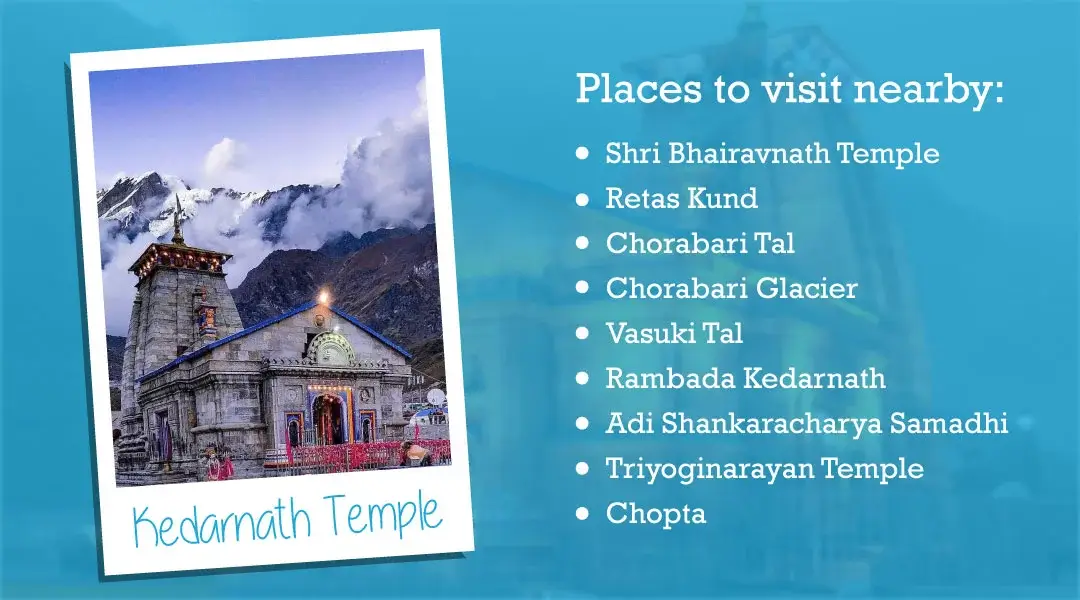
Located 31 km from Gangotri Dham, Kedarnath Dham, dedicated to the Kedar form of Lord Shiva and known as the highest-placed Jyotirlinga in India, is a renowned temple located amidst the lush greenery of the Garhwal Himalayas. The presiding idol of the temple is a triangular black stone, and the temple is situated on the banks of the Mandakini River, a tributary of the holy river Ganga. Moreover, it is believed to be the place where Adi Shankaracharya, the propagator of Advaita philosophy, took his last breath.
According to popular belief, Lord Shiva has been continuously presiding at this sacred site since he made a promise to Nar Narayan upon their request. Legend has it that after the great war of Kurukshetra, the Pandava brothers visited Kedarnath Dham to seek forgiveness for the sin of killing their kin. Bhima pulled Lord Shiva out from hiding in the form of a bull, and upon witnessing the dedication of the Pandavas, Lord Shiva forgave them. Moreover, it is also believed that the Pandavas established the famous Panch Kedar yatra of Uttarakhand, which is visited by devoted Shaivites.
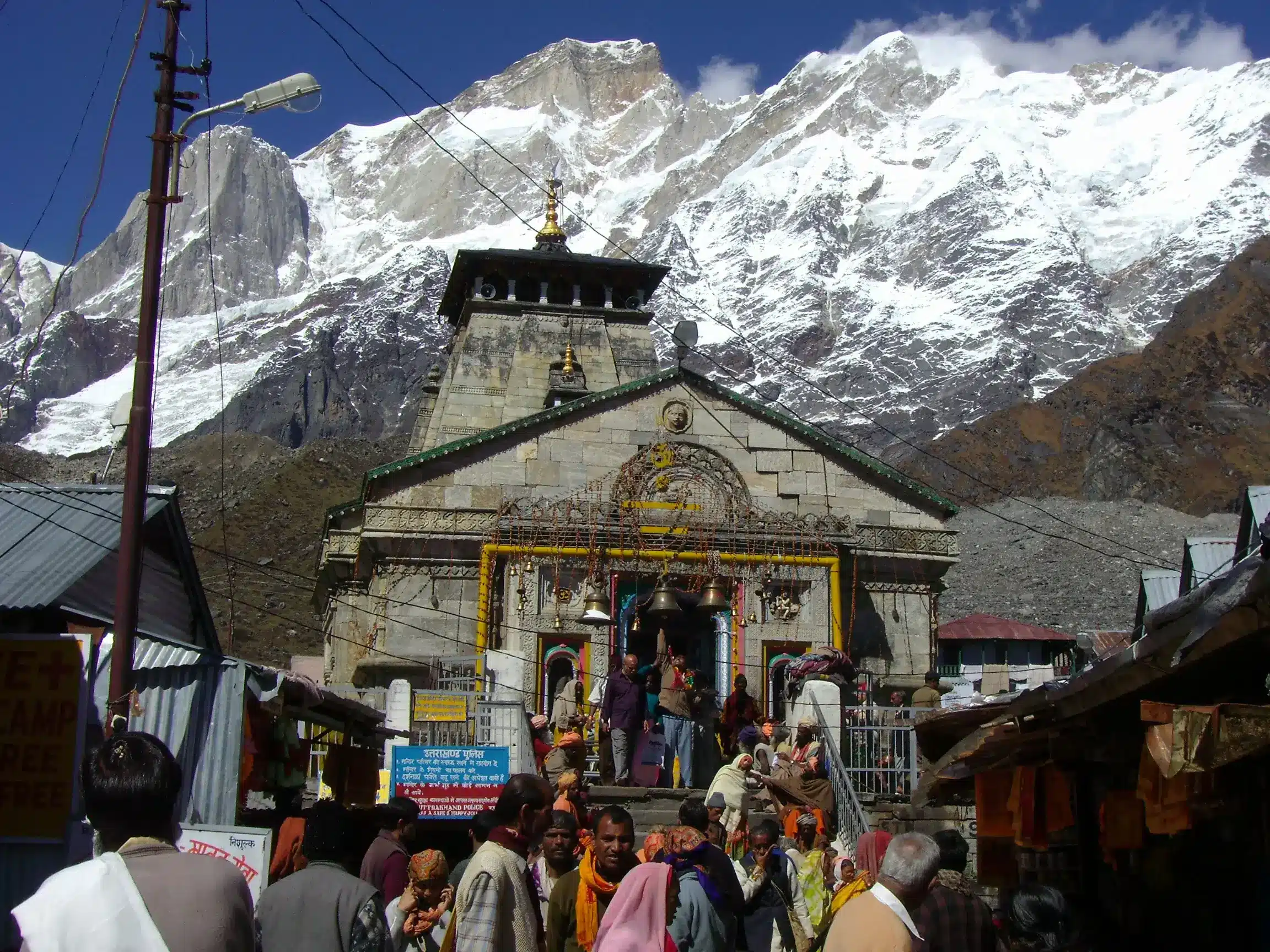
This mythological and historical account adds to the spiritual significance of Kedarnath Dham as a revered pilgrimage destination for Lord Shiva devotees, who come from far and wide to seek blessings and redemption for their sins. Plan your perfect trip to Kedarnath with our list of things to do in Kedarnath temple. Our guide to Kedarnath temple will help you make the most of your visit.
Kedarnath Char Dham Yatra rituals
The Kedarnath Char Dham Yatra rituals typically include the following:
- Kedarnath temple visit – The main ritual of the Kedarnath Char Dham Yatra is the visit to the Kedarnath Temple, which is dedicated to Lord Shiva. Pilgrims trek to the temple located at an altitude of 3,583 meters (11,755 feet) amidst the snow-capped Himalayan peaks. The temple is usually open from April/May to November, and the daily rituals at the temple include morning and evening aarti, bhog (offerings to the deity), and special prayers during festivals and auspicious occasions.
- Rudrabhishek – Rudrabhishek is a special worship ritual performed at the Kedarnath Temple, where offerings of water, milk, honey, ghee, and other sacred materials are made to the Jyotirlinga (a sacred representation of Lord Shiva) while chanting mantras. It is believed to invoke the blessings of Lord Shiva and seek his protection and grace.
- Charan Paduka Darshan – Pilgrims also visit the Charan Paduka, which is believed to be the footprints of Lord Shiva, at Kedarnath. It is located about half a kilometer from the Kedarnath Temple and is considered a sacred spot where Lord Shiva is believed to have meditated.
- Bhairav Temple visit – Another important ritual during the Kedarnath Char Dham Yatra is the visit to the Bhairav Temple, which is dedicated to Bhairav, an incarnation of Lord Shiva. The temple is located near the Kedarnath Temple, and pilgrims offer prayers and seek blessings from Bhairav for a safe and successful pilgrimage.
- Abhishek and Puja – Many pilgrims also perform abhishek (sacred bath) and puja (worship) at various other temples and sacred spots in and around Kedarnath as part of their religious rituals. This involves offering sacred materials like water, milk, honey, and ghee to the deities while chanting prayers and mantras.
- Rudra Path – Pilgrims may also participate in Rudra Path, which is the continuous recitation of Rudram, a Vedic hymn dedicated to Lord Shiva. It is believed to be a highly auspicious and purifying practice during the Kedarnath Char Dham Yatra, and pilgrims often engage in chanting Rudram as part of their spiritual journey.
Badrinath Dham – The divine dham of Lord Vishnu

Located 40 km from Kedarnath Dham, Badrinath Dham which is nestled in the Chamoli district of Dev Bhoomi Uttarakhand, reveres the Badri form of Lord Vishnu. The name “Badrinath ” is derived from the region’s dense covering of Badri or jujube trees. This temple, adorned with vibrant colours, stands as a prominent pillar not only in the Chota Char Dham Yatra of Uttarakhand but also in the revered All India Char Dham Yatra. Against the awe-inspiring backdrop of the snow-clad peaks of Nar and Narayan, Badrinath Dham holds a significant place as a Diva Desam of India, drawing countless pilgrims, especially ardent Vaishnavites, from across the globe.
The origin of Badrinath Dham is steeped in numerous mythological stories. One of the widely accepted beliefs narrates how, during an intense penance, Lord Vishnu’s consort, goddess Laxmi, transformed herself into a Badri tree. She then spread her branches above him to shield him from the harsh weather conditions. Another intriguing legend revolves around how Lord Vishnu cunningly tricked Lord Shiva into leaving Badrinath Dham to make it his abode. These tales add to the spiritual significance and mystique of Badrinath Dham, making it a cherished pilgrimage destination for devotees and pilgrims alike. Our guide to Badrinath temple will help you make the most of your visit.

Badrinath Char Dham Yatra rituals
The Badrinath Char Dham Yatra rituals typically include the following:
- Badrinath Temple visit – The main ritual of the Badrinath Char Dham Yatra is the visit to the Badrinath Temple, which is dedicated to Lord Vishnu in his dual form of Nar and Narayana. Pilgrims visit the temple located at an altitude of 3,415 meters (11,204 feet) and offer prayers to seek blessings and protection. The daily rituals at the temple include morning and evening aarti (ritualistic worship with lamps and incense), bhog (offerings to the deity), and special prayers during festivals and auspicious occasions.
- Tapt Kund Snan – Pilgrims believe that Tapt Kund, a hot water spring located near the Badrinath Temple, has medicinal properties. Hence, before visiting the Badrinath Temple, pilgrims ritually bathe in the hot water of Tapt Kund, considering it purifying and auspicious.
- Charan Paduka Darshan – Pilgrims also visit the Charan Paduka, which is believed to be the footprints of Lord Vishnu, at Badrinath. It is located about half a kilometer from the Badrinath Temple and is considered a sacred spot where Lord Vishnu is believed to have meditated.
- Brahma Kapal Snan – Brahma Kapal is a platform located on the bank of the Alaknanda River near the Badrinath Temple, where pilgrims perform ancestral rituals and offer prayers for the peace and salvation of their departed ancestors. Moreover, taking a ritualistic bath in the icy cold water of the Alaknanda River at Brahma Kapal is considered highly purifying. It is an important ritual during the Badrinath Char Dham Yatra.
- Hemkund Sahib visit – Many pilgrims also visit the revered Hemkund Sahib, a Sikh shrine located near Badrinath, which is associated with Guru Gobind Singh, the tenth Sikh Guru. It is believed to be a place of spiritual significance and pilgrimage for Sikhs, and pilgrims offer prayers, take a ritualistic bath in the holy lake, and participate in community service (seva) at Hemkund Sahib.
- Panch Prayag Darshan – Panch Prayag refers to the five confluences of rivers in the region, namely Devprayag (confluence of Alaknanda and Bhagirathi rivers), Rudraprayag (confluence of Alaknanda and Mandakini rivers), Karnaprayag (confluence of Alaknanda and Pindar rivers), Nandprayag (confluence of Alaknanda and Mandakini rivers), and Vishnuprayag (confluence of Alaknanda and Dhauliganga rivers). Many pilgrims also visit these sacred confluences and offer prayers during their Badrinath Char Dham Yatra as part of their spiritual journey.
- Rudra Abhishek and Puja – Pilgrims may also perform Rudra Abhishek, a sacred ritual involving offerings of water, milk, honey, ghee, and other sacred materials to Lord Shiva, as part of their worship at the Badrinath Temple. This is believed to invoke the blessings of Lord Shiva and seek his protection and grace.
Align with the divine – When to go on Char Dham Yatra
The Char Dham Yatra route is open for only half a year, from April or May to October or November. The exact dates for opening and closing the temples are confirmed by the Mandir Samiti. It happens on the auspicious day of Maha Shivaratri and is determined by the priest of the Bhimashankar Linga Temple.
Since the temples of Char Dham are located at the high peaks, therefore, the weather remains pleasant for most of the year. These temples experience heavy snowfall during the winter season, leading to their closure during the winter months. Hence, the months from April/May to October/November are considered the best time to visit Char Dham. This is because the temples are accessible during this period. During winter, the idols of Kedarnath, Yamunotri, Gangotri, and Badrinath are shifted to other temples like Omkareshwar Temple in Ukhimath, Shani Dev Temple in Kharsali, Vasu Dev Temple in Joshimath, and Mukhimath Temple in Mukba, where they are worshipped during the winter season.

Char Dham Yatra in 2024
The doors of Gangotri-Yamunotri and Kedarnath Dham were opened for devotees on 10th May and those of Badrinath Dham on 12th May. The other two temples, Kedarnath and Badrinath, will be open to pilgrims from the third or fourth week of May, just a few days after the opening of Yamunotri and Gangotri. The closing ceremony for Badrinath Dham will take place on the auspicious day of Vijay Dashami, followed by the closing of Gangotri Dham on the festival of lights, Diwali, and Kedarnath and Yamunotri Dhams simultaneously on Yama Dwitiya/Bhai Dooj.
| Opening dates of Chardham Yatra for 2024 | Closing dates of Chardham Yatra for 2024 | |
| Yamunotri Temple – 10 May 2024 | Yamunotri Temple –
(Tentative) |
|
| Gangotri Temple – 10 May 2024 | Gangotri Temple –
(Tentative) |
|
| Kedarnath Temple – 10 May 2024 | Kedarnath Temple – 02 November 2024 (Tentative) |
|
| Badrinath Temple – 12 May 2024 | Badrinath Temple – 09 November 2024 (Tentative) |
Pilgrim’s guide – How to prepare for Char Dham Yatra
Preparing for the Char Dham Yatra requires careful planning and preparation to ensure a safe and smooth pilgrimage. Here are some tips on how to prepare for the Char Dham Yatra:
- Obtain necessary permits – Char Dham Yatra requires permits from the respective authorities. Make sure to obtain all the necessary permits and permissions required for the pilgrimage. This includes Inner Line Permits (ILP) for certain areas, in advance to avoid any last-minute hassles.
- Check weather conditions – The Char Dham Yatra takes place in high-altitude regions where weather conditions can be unpredictable. Check the weather forecast before embarking on the pilgrimage and pack accordingly, including warm clothes, rain gear, and sunscreen.
- Physical fitness – Char Dham Yatra route involves trekking and walking on uneven terrains. It is important to be physically fit to cope with the physical demands of the pilgrimage. Start preparing yourself physically by exercising, walking, and doing regular cardio workouts well in advance of the yatra.
- Medications and first aid – Carry a basic first aid kit that includes essential medications such as pain relievers, altitude sickness medication, anti-diarrheal medicine, bandages, and any personal medications that you may require during the yatra.
- Proper clothing and footwear – Pack appropriate clothing for the yatra, including warm clothes for the cold weather, rain gear, and comfortable walking shoes with good grip to navigate the uneven terrains.
- Pack essentials – Carry essential items such as a torch, extra batteries, power banks, water bottles, snacks, toiletries, sunglasses, hats, and a camera to capture the beautiful landscapes during the yatra.
- Stay hydrated – It is important to stay hydrated during the Char Dham Yatra route as the high-altitude regions can cause dehydration. Carry enough water bottles and drink plenty of fluids to stay hydrated throughout the pilgrimage.
- Respect local customs and traditions – Char Dham Yatra is a pilgrimage that holds religious significance for Hindus. Respect the local customs, traditions, and religious sentiments of the locals and fellow pilgrims. Dress modestly and follow the rules and regulations of the temples and the pilgrimage.
- Plan for accommodation – Plan your accommodation in advance, especially during the peak season of Char Dham Yatra, as availability may be limited. Book hotels, guest houses, or Dharamshalas (pilgrims’ rest houses) as per your budget and preferences.
Always prioritize your safety during the yatra. Follow the instructions of the local authorities, avoid trekking during extreme weather conditions, take necessary precautions against altitude sickness, and be cautious while crossing rivers or walking on steep trails. By following these tips and making the necessary preparations, you can ensure a safe and fulfilling Char Dham Yatra route, and have a spiritually enriching pilgrimage experience.
Spiritual Heights – Char Dham Yatra by helicopter

Char Dham Yatra by helicopter is a convenient option for pilgrims who want to visit the four sacred shrines. Hence, it allows pilgrims to cover the long distances and challenging terrains of the Himalayas in a much shorter time compared to traditional trekking or road routes.
Helicopter services for the Char Dham Yatra route are provided by various private tour operators and aviation companies in collaboration with the Uttarakhand government. These operators offer helicopter packages that include transportation from the base points to the respective shrines, VIP darshans (worship), and other necessary arrangements. The helicopter services are especially popular among elderly pilgrims, those with physical limitations, or those with time constraints. They provide a more convenient and comfortable way to undertake the yatra.
It’s important to note that helicopter services for the Char Dham Yatra route are subject to weather conditions, availability, and permissions from the local authorities. Pilgrims need to plan and book their helicopter tickets well in advance. They will also have to follow all the guidelines and rules set by the tour operators and the authorities for a safe and successful pilgrimage experience.
Other Char Dham transportation services
Here are some transportation services that are available during the Char Dham Yatra for elderly or physically challenged individuals:
- Palanquins (Palki or Palaki) – Palanquins are portable seats carried by a team of porters or palanquin bearers. They are commonly used in India for transportation in hilly or remote areas where other means of transportation may not be feasible. Palanquins can be a comfortable option for those who may have difficulty walking or navigating difficult terrains.
- Ponies or Horses – Furthermore, ponies or horses can be hired for transportation during the Char Dham Yatra. Trained handlers or guides usually accompany them, and they can provide a relatively quicker mode of transportation compared to walking, especially for those who may have limited mobility or endurance.
- Porters – Porters or helpers can be hired to carry luggage or provide assistance to elderly or physically challenged pilgrims on the Char Dham Yatra route. Porters are familiar with the local terrain and can help carry heavy luggage, making the journey easier for those who may have limited mobility.
- Mules – Additionally, mules can also be used as a means of transportation for the Char Dham Yatra route. Mules are trained and commonly used for transporting goods and people in hilly or remote areas. They can provide a sturdy mode of transportation for elderly or physically challenged pilgrims, especially for longer distances or challenging terrains.
It’s important to note that the availability and usage of these transportation services may vary depending on factors such as weather conditions, accessibility, and local regulations. It’s recommended to plan ahead, make necessary arrangements in advance, and follow all safety guidelines and instructions provided by the service providers or local authorities.
Char Dham Yatra facilities for elderly and female travelers
Facilities for elderly and female travelers are taken into consideration during the Char Dham Yatra. This is to ensure their comfort and safety. Some of the facilities provided for elderly and female travelers during the pilgrimage include:
- Accommodation – Many tour operators offer accommodation options that are suitable for elderly and female travelers. It includes rooms with easy access, comfortable beds, and attached bathrooms. Special arrangements can also be made for female travelers, such as separate rooms or floors for female pilgrims.
- Transportation – Helicopter services for the Char Dham Yatra route can be a convenient option for elderly and female travelers. They offer a quicker and more comfortable mode of transportation compared to trekking or road routes. Helicopter services often have provisions for comfortable seating. They also provide special assistance to elderly travelers during boarding and deboarding.
- Medical facilities – Medical facilities are available at the base points and en route to the Char Dham Yatra. They provide medical aid to elderly and female travelers in case of any health emergencies. It is advisable to carry the necessary medications and consult with a healthcare professional before embarking on the pilgrimage.
- Assistance for female travelers – Many tour operators and local authorities provide special assistance and facilities for female travelers. They include separate queues for darshans (worship), designated restrooms, and security arrangements. This is to ensure their safety and comfort during the pilgrimage.
- Safety measures – Adequate safety measures, such as well-maintained paths, handrails, and barricades, are usually in place to ensure the safety of elderly and women travelers during the Char Dham Yatra. It is important to follow all safety guidelines and instructions provided by the authorities and tour operators for a safe and successful pilgrimage experience.
Flavors of faith – Culinary experiences in Char Dham Yatra
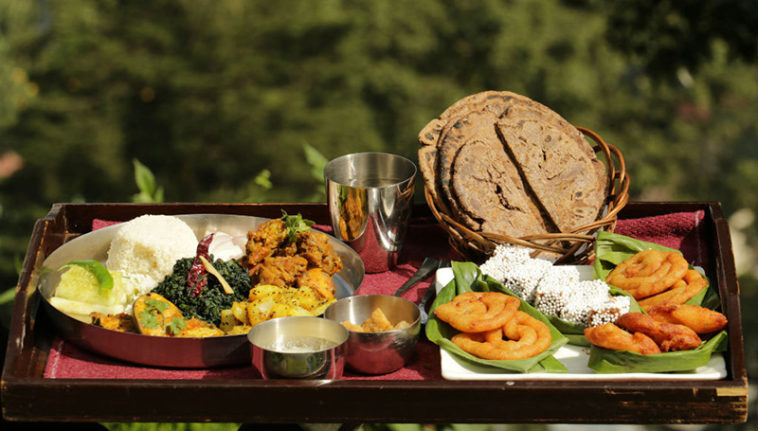
The Char Dham Yatra is not just a spiritual pilgrimage, but also a culinary adventure. The region captivates your taste buds with its diverse landscapes and rich cultural heritage, offering a wide array of delicious and authentic dishes. You must not miss the opportunity to indulge in the local cuisine, which is a delightful blend of flavors and culinary traditions. Pahari cuisine is typical of the mountainous regions of Uttarakhand. They offer simple yet delicious dishes like Bhaang ki Khatai, a sweet flatbread made with hemp flour. Rus, a popular drink made from boiled rice, milk, and sugar. And Aloo ke Gutke, boiled potatoes mixed with spices and ginger.
Garhwali cuisine is known for its hearty and filling dishes. It includes Kafuli, a thick green leafy vegetable dish, Chainsoo, a spicy and tangy dish made with mashed potatoes, and Bal Mithai, a sweet ball made from chocolate and sugar. These local delicacies are sure to warm your heart and tantalize your taste buds on your Char Dham Yatra route.
Besides the local cuisine, popular dishes include Rajma-Chawal, Kadhi-Chawal, Aloo Poori, Kachaudi, and sweets like Kheer, Halwa, and Ladoo. These dishes are commonly available at local restaurants, at street food stalls, and as prasad (offering) at the temples. So, here are some restaurants you can eat at during your Char Dham yatra.
Places to eat in Yamunotri Dham
- Om Shanti Guest House And Restaurant, Beef village
- Palace Jankichatti, Janki Chatti
- Hotel Jai Restaurant, Barkot Yamunotri Road
Restaurants in Gangotri Dham
- Hotel Krishna Palace And Restaurant
- Shree Balaji Rajasthani Restaurant
- Shiva restaurant
Places to eat in Kedarnath Dham
- Hariyali Restaurant
- Chauhan Guest House
- Magpie Restaurant
Restaurants in Badrinath Dham
- Sardeshwari Restaurant
- Saket Restaurant
- Mishra restaurant
- Vankatesh
Additionally, in a bid to promote local cuisines and support women’s empowerment, the Rudraprayag district administration has introduced the concept of opening eateries serving traditional foods for pilgrims undertaking the Char Dham Yatra. Notably, the packing of the food items is in environmentally-friendly paper-made utensils.
Along the 16-km trek route from Gaurikund to Kedarnath, the district administration has allocated 10 shops to women’s self-help groups who will manage these eateries. These shops will now showcase local cuisines. They will also add an ‘Uttarakhandi touch’ to the food which will be served to the lakhs of pilgrims who come for the annual pilgrimage. This initiative is expected to provide employment to around 100 women for a duration of six months, promoting local cuisine and supporting women’s empowerment in the region.
Accommodation in Char Dham Yatra
Accommodation options during the Char Dham Yatra are available in the form of guesthouses, dharamshalas (pilgrim rest houses), hotels, and campsites. These options cater to the varying needs and preferences of pilgrims, offering a range of budget-friendly luxury accommodations.
Places to stay in Yamunotri
- Hotel Ganga Yamuna
- Hotel Krishna Palace
- The Yamunotri Cottages
Accommodations in Gangotri
- Hotel Gangaputra
- Char Dham Camp Harsil
- Chandra Lok Cottage
- Mandakini Hotel
- Manisha Guest House
Places to stay in Kedarnath
- Punjab Sindh Awas
- Gayatri Sadan
- Rajasthan Sadan
- Himachal House
- Gurudham Hotel
- Hotel Behl Ashram
Hotels in Badrinath
- Sarovar Portico Badrinath
- Hotel New Snow Crest
- Hotel Yoga Badrinath
- Narayan Palace Hotel
Embarking on the Char Dham Yatra is truly a spiritual and transformative journey. It takes pilgrims on a sacred pilgrimage through the pristine landscapes of Uttarakhand. From the awe-inspiring temples of Yamunotri, Gangotri, Kedarnath, and Badrinath to the breathtaking vistas of the Himalayas, this pilgrimage is a pilgrimage of faith, devotion, and self-discovery. The Char Dham Yatra is also an opportunity to appreciate the natural beauty, cultural heritage, and traditional way of life of the people living in the region.
The experience of undertaking this sacred pilgrimage leaves an indelible mark on the hearts and minds of the pilgrims, and they return home with a sense of spiritual rejuvenation and enlightenment. The most convenient way to commence your yatra is by booking a reliable car rental app to take you around these holy destinations so that on your way back, the only thing on your mind is all the spiritual memories you’re going to carry throughout your life.
So, if you seek a journey of self-discovery, spiritual awakening, and closer communion with the divine, the Char Dham Yatra is an experience of a lifetime that will leave you enriched and transformed.
Useful links:
- Char Dham Yatra 2024 Begins From May 10; Here’s How To Book Heli Services, Know Fare, Other Details
- Char Dham Yatra by helicopter
- Char Dham Yatra registration
- Online Puja booking
- Government guest houses on the Char Dham Yatra route
- Advisory Issued For Pilgrims Visiting Kedarnath, Badrinath, Yamunotri, Gangotri
- Chardham Yatra: Pilgrims to get best health services en route
- Reliance rolls out 5G services in Chardham temple premises
- Chardham Yatra: Govt Issues Health Advisory In 11 Languages For Pilgrims
Last Updated on November 25, 2024 by V Subhadra




